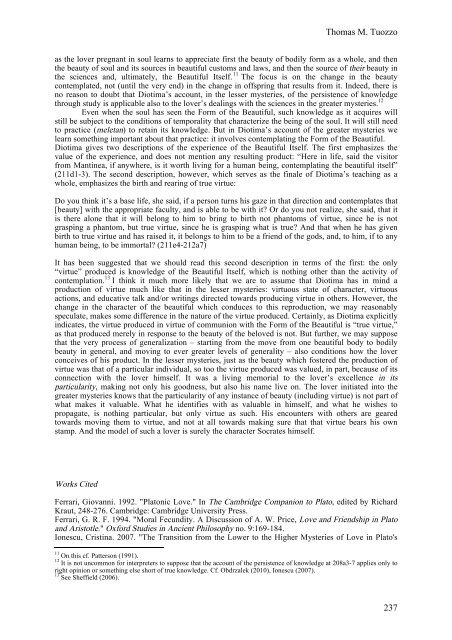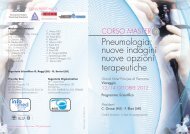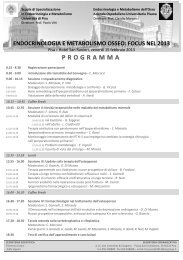Create successful ePaper yourself
Turn your PDF publications into a flip-book with our unique Google optimized e-Paper software.
Thomas M. Tuozzo<br />
as the lover pregnant in soul learns to appreciate first the beauty of bodily form as a whole, and then<br />
the beauty of soul and its sources in beautiful customs and laws, and then the source of their beauty in<br />
the sciences and, ultimately, the Beautiful Itself. 11 The focus is on the change in the beauty<br />
contemplated, not (until the very end) in the change in offspring that results from it. Indeed, there is<br />
no reason to doubt that Diotima’s account, in the lesser mysteries, of the persistence of knowledge<br />
through study is applicable also to the lover’s dealings with the sciences in the greater mysteries. 12<br />
Even when the soul has seen the Form of the Beautiful, such knowledge as it acquires will<br />
still be subject to the conditions of temporality that characterize the being of the soul. It will still need<br />
to practice (meletan) to retain its knowledge. But in Diotima’s account of the greater mysteries we<br />
learn something important about that practice: it involves contemplating the Form of the Beautiful.<br />
Diotima gives two descriptions of the experience of the Beautiful Itself. The first emphasizes the<br />
value of the experience, and does not mention any resulting product: “Here in life, said the visitor<br />
from Mantinea, if anywhere, is it worth living for a human being, contemplating the beautiful itself”<br />
(211d1-3). The second description, however, which serves as the finale of Diotima’s teaching as a<br />
whole, emphasizes the birth and rearing of true virtue:<br />
Do you think it’s a base life, she said, if a person turns his gaze in that direction and contemplates that<br />
[beauty] with the appropriate faculty, and is able to be with it? Or do you not realize, she said, that it<br />
is there alone that it will belong to him to bring to birth not phantoms of virtue, since he is not<br />
grasping a phantom, but true virtue, since he is grasping what is true? And that when he has given<br />
birth to true virtue and has raised it, it belongs to him to be a friend of the gods, and, to him, if to any<br />
human being, to be immortal? (211e4-212a7)<br />
It has been suggested that we should read this second description in terms of the first: the only<br />
“virtue” produced is knowledge of the Beautiful Itself, which is nothing other than the activity of<br />
contemplation. 13 I think it much more likely that we are to assume that Diotima has in mind a<br />
production of virtue much like that in the lesser mysteries: virtuous state of character, virtuous<br />
actions, and educative talk and/or writings directed towards producing virtue in others. However, the<br />
change in the character of the beautiful which conduces to this reproduction, we may reasonably<br />
speculate, makes some difference in the nature of the virtue produced. Certainly, as Diotima explicitly<br />
indicates, the virtue produced in virtue of communion with the Form of the Beautiful is “true virtue,”<br />
as that produced merely in response to the beauty of the beloved is not. But further, we may suppose<br />
that the very process of generalization – starting from the move from one beautiful body to bodily<br />
beauty in general, and moving to ever greater levels of generality – also conditions how the lover<br />
conceives of his product. In the lesser mysteries, just as the beauty which fostered the production of<br />
virtue was that of a particular individual, so too the virtue produced was valued, in part, because of its<br />
connection with the lover himself. It was a living memorial to the lover’s excellence in its<br />
particularity, making not only his goodness, but also his name live on. The lover initiated into the<br />
greater mysteries knows that the particularity of any instance of beauty (including virtue) is not part of<br />
what makes it valuable. What he identifies with as valuable in himself, and what he wishes to<br />
propagate, is nothing particular, but only virtue as such. His encounters with others are geared<br />
towards moving them to virtue, and not at all towards making sure that that virtue bears his own<br />
stamp. And the model of such a lover is surely the character Socrates himself.<br />
Works Cited<br />
Ferrari, Giovanni. 1992. "Platonic Love." In The Cambridge Companion to Plato, edited by Richard<br />
Kraut, 248-276. Cambridge: Cambridge University Press.<br />
Ferrari, G. R. F. 1994. "Moral Fecundity. A Discussion of A. W. Price, Love and Friendship in Plato<br />
and Aristotle." Oxford Studies in Ancient Philosophy no. 9:169-184.<br />
Ionescu, Cristina. 2007. "The Transition from the Lower to the Higher Mysteries of Love in Plato's<br />
11 On this cf. Patterson (1991).<br />
12 It is not uncommon for interpreters to suppose that the account of the persistence of knowledge at 208a3-7 applies only to<br />
right opinion or something else short of true knowledge. Cf. Obdrzalek (2010), Ionescu (2007).<br />
13 See Sheffield (2006).<br />
237




